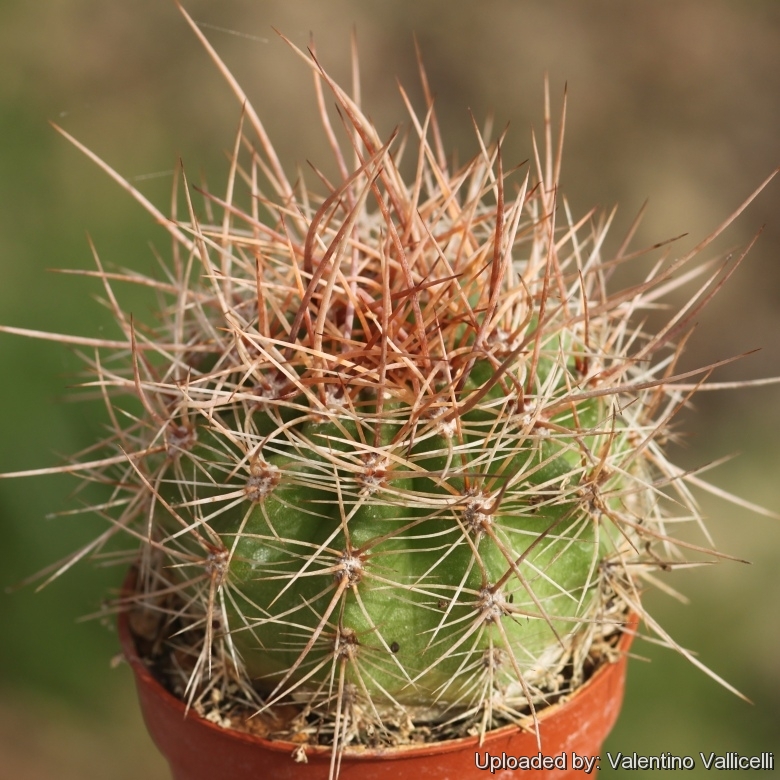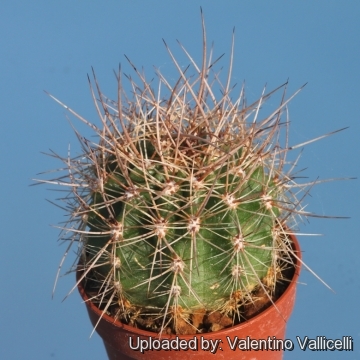




Your support is critical to our success.
Cactaceae Syst. Init. 14: 13. 2002 [Oct 2002]
Family: CACTACEAE
Accepted Scientific Name: Echinopsis formosa (Pfeiff.) Jacobi ex Salm-Dyck
Cact. Hort. Dyck. (1849) 39. 1850 [1-6 Apr 1850]

Origin and Habitat: Echinopsis formosa is widespread in a wide area comprising Catamarca, western Argentina and Chile on both sides of the Andes.
The subsp. rosarioana is endemic to Sierra Famatina (Carrizal, Los Corrales, Cuevas de Noroña, Miranda, La Mexicana, Angosturas) La Rioja, Argentina.
Altitude: Up to about 3500 m.a.s.l.
Habitat: Valleys and rocky slopes of the Andes amongst short grasses in fully exposed sites. Inhabitants must be very rugged in order to tolerate such extremes in exposure. Echinopsis formaosa is such a robust individual. However in habitat the plant is often bathed in fog during the summer months and even when exposed to full sun, heat is typically not a factor.
Synonyms:
- Echinopsis formosa subs. rosarioana (Rausch) M.Lowry
- Lobivia formosa var. rosarioana (Rausch) Rausch
- Lobivia rosarioana Rausch
Echinopsis formosa (Pfeiff.) Jacobi ex Salm-Dyck
Cact. Hort. Dyck. (1849) 39. 1850 [1-6 Apr 1850]
Synonymy: 29
- Echinopsis formosa (Pfeiff.) Jacobi ex Salm-Dyck
- Acanthocalycium formosum (hort. ex Pfeiff.) Backeb.
- Cereus gilliesii F.A.C.Weber in Bois
- Echinocactus formosus Pfeiff.
- Echinonyctanthus formosus Lawr.
- Lobivia formosa (Pfeiff.) Dodds
- Soehrensia formosa (Pfeiff.) Backeb.
- Trichocereus formosus (Pfeiff.) F.Ritter
- Echinopsis formosa subs. kieslingii (Rausch) M.Lowry
- Echinopsis kieslingii (Rausch) Anceschi & Magli
- Lobivia kieslingii Rausch
- Echinopsis formosa var. maxima (Backeb.)
- Soehrensia formosa var. maxima Backeb.
- Echinopsis formosa var. pinchasensis (Rausch)
- Echinopsis formosa var. polycephala (Backeb.)
- Echinopsis formosa subs. rosarioana (Rausch) M.Lowry
- Lobivia formosa var. rosarioana (Rausch) Rausch
- Lobivia rosarioana Rausch
- Echinopsis oreopogon (Speg.) Werderm.
- Acanthocalycium oreopogon (Werderm. ex Speg.) Backeb. in Backeb. & F.M.Knuth
- Lobivia oreopepon Speg.
- Lobivia oreopogon Werderm. in Backeb. & Werderm.
- Soehrensia oreopepon (Speg.) Backeb.
- Echinopsis uebelmanniana (Lembcke & Backeb.) A.E.Hoffm.
- Lobivia formosa var. uebelmanniana (Lembcke & Backeb.) Rausch
- Soehrensia uebelmanniana Lembcke & Lembcke
- Trichocereus uebelmannianus (Lembcke & Lembcke) F.Ritter
Echinopsis formosa var. albispina F.A.C.Weber ex Schelle
Handb. Kakteenkult. 118 118 1907
Synonymy: 2
- Echinopsis formosa var. albispina F.A.C.Weber ex Schelle
- Acanthocalycium formosanum var. albispinum (F.A.C.Weber ex Schelle) Y.Itô
Echinopsis formosa subs. korethroides (Werderm.) M.Lowry
Cactaceae Syst. Init. 14: 13. 2002 [Oct 2002]
Synonymy: 6
- Echinopsis formosa subs. korethroides (Werderm.) M.Lowry
- Echinopsis korethroides Werderm.
- Eriosyce korethroides (Werderm.) Backeb. in Backeb. & F.M.Knuth
- Lobivia korethroides (Werderm.) Werderm.
- Soehrensia korethroides (Werderm.) Backeb.
- Trichocereus korethroides (Werderm.) H.P.Kelsey & Dayton
Echinopsis formosa subs. randallii (Cárdenas) M.Lowry
Cactaceae Syst. Init. 14: 13. 2002 [Oct 2002]
Synonymy: 5
- Echinopsis formosa subs. randallii (Cárdenas) M.Lowry
- Echinopsis randallii (Cárdenas) H.Friedrich & G.D.Rowley
- Helianthocereus randallii (Cárdenas) Backeb.
- Lobivia formosa var. randallii (Cárdenas) Rausch
- Trichocereus randallii Cárdenas
SPANISH (Español): Koko, Pasacana
Description: Echinopsis formosaSN|48]]SN|48]] subs. rosarioana is probably one of the many geographical forms of the extremely variable Echinopsis formosaSN|48]]SN|48]]. The dense golden or amber coloured spines would protect them from the extremes of cold and sunshine. The new spines are actually dark brown and appear in the spring.
Habit: Echinopsis formosaSN|48]]SN|48]] is a massive growing barrel cactus with a solid and spiny presence, solitary at first, later branching basally to form wide colonies.
Stem: Globose to columnar, multiply- ribbed, pale green or blue-green, up to 0,5-1(-2) m tall, 20-35(-50) cm in diameter.
Ribs: 15-35(-50) vertical with remarkable notches and tubercles.
Areoles: Elliptic, initially covered by a dark-brown down and about 1 cm apart.
Radial spines: 8-16, needle-like, spreading, straight or slightly curved, colourful yellowish, amber or reddish brown, up to 3 (or more) cm long
Central spines: 2-9, acicular, brown, of variable length which, in some cases, can reach the 20 cm.
Flowers: Fire yellow to orange-red to red, funnel-shaped, diurnal, originating in the apical zone and are about 6-9 cm long and broad.
Blooming period: Open in the day in the spring.
Fruit: Globose, 3-4 cm of diameter, acid green, covered by scales and down; the pulp is white, edible, and contains several black seeds. It usually reproduces by seed.
Subspecies, varieties, forms and cultivars of plants belonging to the Echinopsis formosa group
- Echinopsis formosa (Pfeiff.) Jacobi ex Salm-Dyck
 Echinopsis formosa subs. kieslingii (Rausch) M.Lowry: has stem to 20 cm in diameter with spines always curved, flower lateral near the tip, with narrow-lanceolate perianth segment and the very short style. Distribution: Tucuman, Sierra de Quilmes, Argentina.
Echinopsis formosa subs. kieslingii (Rausch) M.Lowry: has stem to 20 cm in diameter with spines always curved, flower lateral near the tip, with narrow-lanceolate perianth segment and the very short style. Distribution: Tucuman, Sierra de Quilmes, Argentina. Echinopsis formosa subs. korethroides (Werderm.) M.Lowry
Echinopsis formosa subs. korethroides (Werderm.) M.Lowry- Echinopsis formosa subs. randallii (Cárdenas) M.Lowry
 Echinopsis formosa subs. rosarioana (Rausch) M.Lowry
Echinopsis formosa subs. rosarioana (Rausch) M.Lowry
Bibliography: Major references and further lectures
1) Walter Rausch “Lobivia: The Day Flowering Echinopsidinae from a Geographical Distribution Point of View” Volumes 1-3 R. Herzig, 1975
2) Edward Anderson “The Cactus family” Timber Press, Incorporated, 2001
3) James Cullen, Sabina G. Knees, H. Suzanne Cubey "The European Garden Flora Flowering Plants: A Manual for the Identification of Plants Cultivated in Europe, Both Out-of-Doors and Under Glass" Cambridge University Press, 11/Aug/2011
4) David R Hunt; Nigel P Taylor; Graham Charles; International Cactaceae Systematics Group. "The New Cactus Lexicon" dh books, 2006
5) N. L. Britton, J. N. Rose “The Cactaceae. Descriptions and Illustrations of Plants of the Cactus Family.” Volume 4, The Carnegie Institution of Washington, Washington 1923,
6) Curt Backeberg: “Die Cactaceae: Handbuch der Kakteenkunde” Volume V, Gustav Fischer Verlag, Stuttgart New York 1982–1985
7) Demaio, P., Lowry, M., Ortega-Baes, P., Perea, M., Trevisson, M., Faundez, L. & Saldivia, P. 2013. Echinopsis formosa. In: IUCN 2013. "IUCN Red List of Threatened Species." Version 2013.2. <www.iucnredlist.org>. Downloaded on 09 January 2014.

Echinopsis formosa subs. rosarioana Photo by: Valentino Vallicelli
The gallery now contains thousands of pictures, however it is possible to do even more. We are, of course, seeking photos of species not yet shown in the gallery but not only that, we are also looking for better pictures than those already present. Read More...
Cultivation and Propagation: Echinopsis formosaSN|48]]SN|48]] is very easy to grow and cold hardy as low as -12°C (or less). Need a fertile, well drained soil mix. Water the plants well and allow them to dry before watering again. During the growing season fertilize them monthly with a balanced fertilizer. Plants grown in the ground form soon imposing specimens.
Sun Exposure: Outside full sun, at the maximum possible luminosity, inside needs bright light, and some direct sun. When cultivating this plant in low elevation zones where it is very hot, a bit of shade may benefit this plant in summer.
Winter rest: During winter month, put them in a cool luminous place and encourage them to enter winter dormancy by withholding water and fertiliser over the winter as they will etiolate, or become thin, due to lower levels of light. Keep them dry with temperatures possibly between 0 and 5°C (or even less), this period of cold and dry rest is useful for stimulating the blossoming.
Pest & diseases: They are susceptible to fungal diseases if overwatered, but are not nearly as sensitive as many other cacti, especially in warm weather. If kept damp through cold periods, they will invariably suffer.
Propagation: It usually reproduces by seed or sometime by cuttings (rarely available). The flower colour is not always true from seeds.
| Your Actions | |
|---|---|
| Back to Echinopsis index | |
| Back to Cactaceae index | |
 |
Back to Cacti Encyclopedia index |
Privacy stantement - Terms and conditions - How to cite - About us - Feedback - Donate




